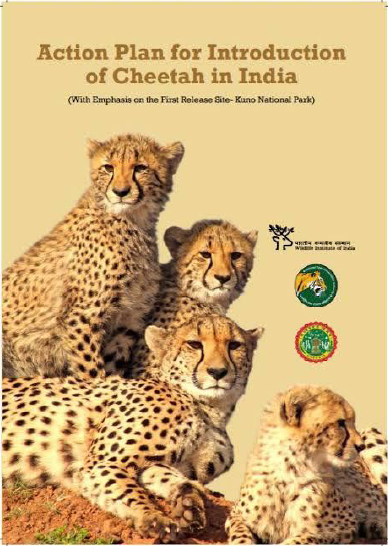Cheetah was the only large carnivore that went extinct in India in 1952 due to over hunting and habitat loss.
Asiatic cheetah – African cheetah
| ASIATIC CHEETAH | AFRICAN CHEETAH |
|---|---|
| Slightly smaller and thinner | Larger and thicker in comparison |
| Pale yellowish fawn coloured skin | Brownish and golden skin |
| More fur under body | More prominent spots and lines on face |
| IUCN status: Critically endangered | IUCN status: Vulnerable |
| Extinct in India, Found in Iran | Found all over African continent |
The Cheetah Reintroduction Project
 commenced on September 17, 2022.
commenced on September 17, 2022.- According Wildlife Institute of India, 50 wild cheetahs would be imported as a founder stock over five years.
- 8 cheetahs from Namibia and 12 from South Africa were reintroduction in Kuno-Palpur National Park, MP.
- This is the world’s first inter-continental large wild carnivore translocation project.
- The project is implemented by the National Tiger Conservation Authority in collaboration with the Madhya Pradesh Forest Department, Wildlife Institute of India (WII), and cheetah experts from Namibia and South
Africa.
Why Kuno National Park?
- Suitable (Savannah grassland) habitat
- Adequate prey base
- Devoid of human settlement
- Enables coexistence of four big cats – Tiger, leopard, Lion, Cheetah.
Why are we bringing in African Cheetah?
- African cheetah is found to be the ancestor to all other Cheetahs.
- Asiatic cheetah found only in Iran is categorized as critically endangered.
- African Cheetahs have a high genetic variation necessary for a founding population.
Significance
- Biodiversity restoration: Introduction of a top predator will be beneficial
to restoration of ecosystem. - Serve as model for conservation efforts of other species
- Opportunity for research
- Enhance economy through tourism
 Challenges to project Cheetah
Challenges to project Cheetah
- Less protected area available for thriving Cheetah Population
- Less prey availability: cheetahs travelling large distances to roam and hunt which is not optimal
- Fragile compared to other big cats: more prone to sustaining fatal injuries in the wild.
- Inter species competition: Proximity to Ranthambore Tiger Reserve
- Asiatic cheetahs may have been a more suitable choice considering historical survival of species in the region.
Way Forward
- Improvement of health monitoring along with long term conservation plan
- Strengthening collaboration and coordination
- Expansion of habitat area
- Encouraging community-based conservation
- protection of native species and their habitat should get equal consideration
 Chinmaya IAS Academy – Current Affairs Chinmaya IAS Academy – Current Affairs
Chinmaya IAS Academy – Current Affairs Chinmaya IAS Academy – Current Affairs



